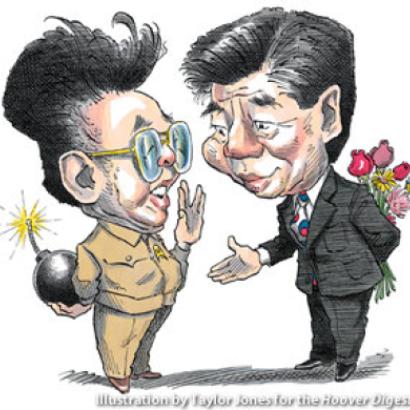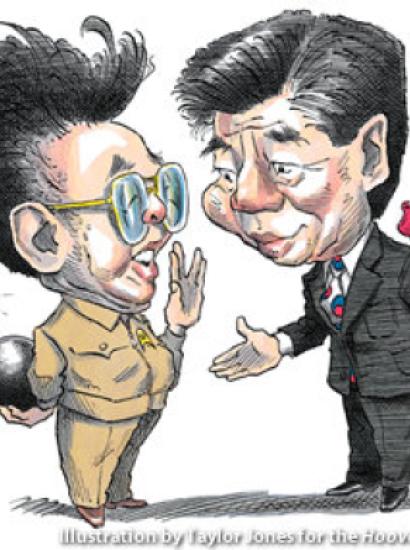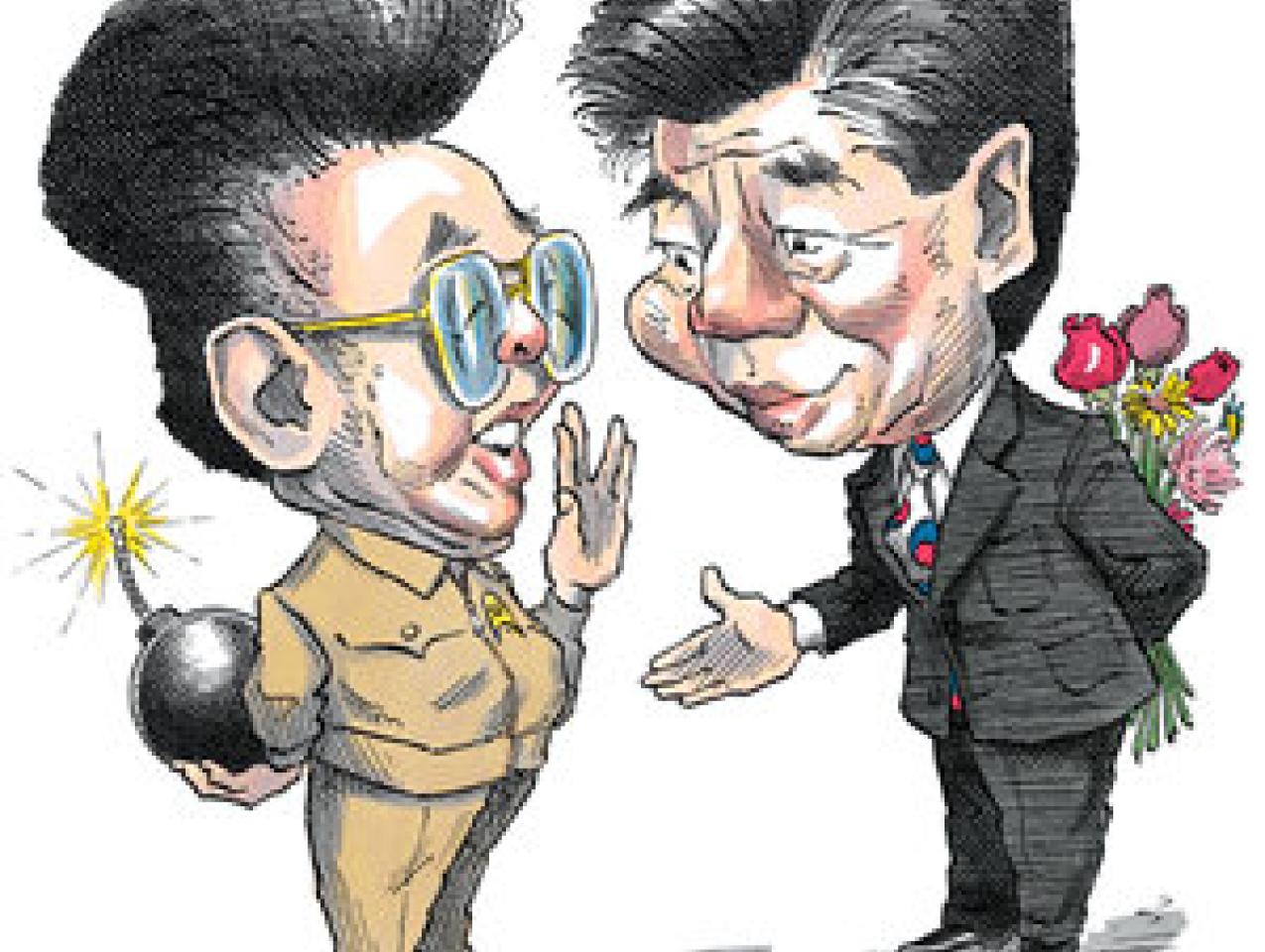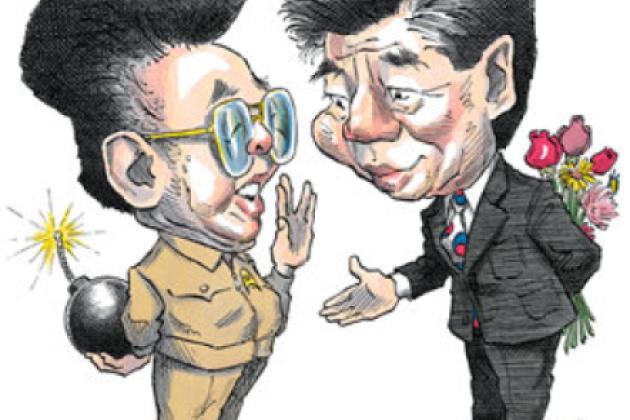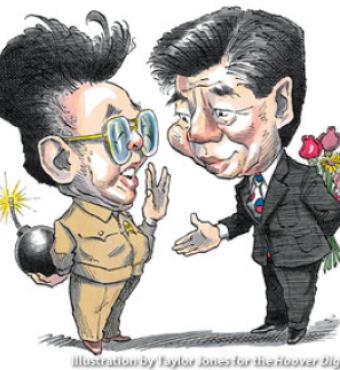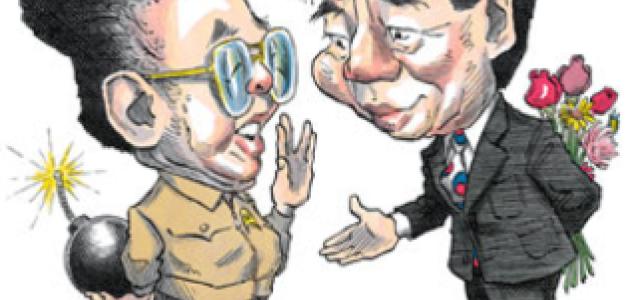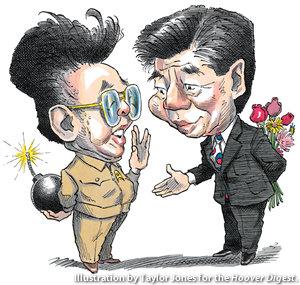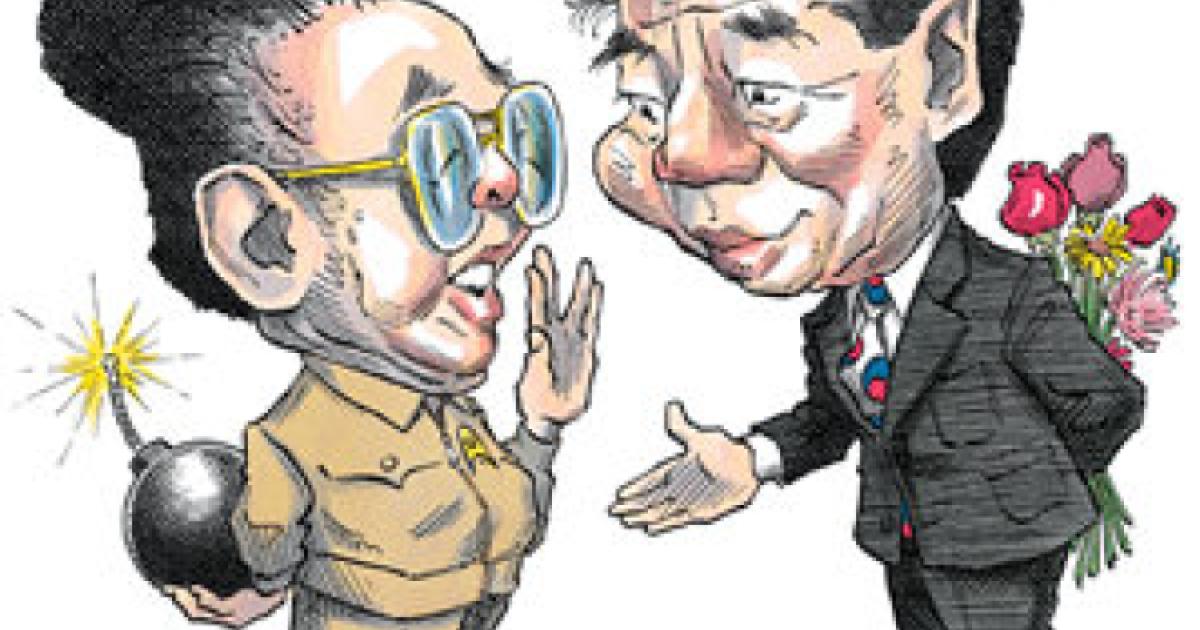- International Affairs
- US Foreign Policy
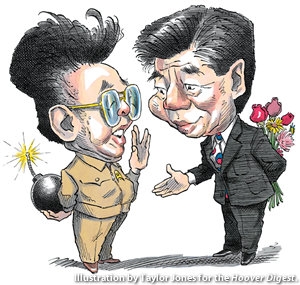
The crisis emerged in October last year when Assistant Secretary of State for East Asia James Kelly visited Pyongyang, the first high-level exchange in a bilateral setting between Washington and North Korea since the beginning of the Bush administration. During talks, Secretary Kelly presented his counterparts with compelling evidence that Pyongyang had a clandestine program to produce highly enriched uranium 235—a critical ingredient for atomic bombs. This program violated the spirit and letter of previous agreements, in particular, the 1994 Agreed Framework between Washington and Pyongyang that suspended North Korea’s nuclear programs at its Yongbyon complex. After initial denials, the North Korean negotiators acknowledged the existence of the program but intimated that Pyongyang would end such efforts if Washington would sign a non-aggression pact.
In November, Washington responded by suspending shipments of fuel oil to North Korea, one of its commitments under the 1994 Agreed Framework, and declared that it would not reward Pyongyang’s behavior with new negotiations. In December, Pyongyang announced that Washington’s action effectively nullified the 1994 Agreed Framework and announced that it would reopen its Yongbyon complex. Later that month it expelled inspectors of the International Atomic Energy Agency (IAEA). It removed IAEA surveillance cameras and seals from the Yongbyon facilities and began preparations to restart the five-megawatt reactor whose operation had been suspended since 1994. In addition, Pyongyang announced that it would reopen the facility at Yongbyon for reprocessing spent nuclear fuel—a process that could extract plutonium, an alternative critical ingredient for nuclear weapons. In the long term, such fuel for reprocessing would come from the operation of the Yongbyon reactors. But more immediately, it could be derived from 8,000 fuel rods that had been downloaded from the Yongbyon reactors a decade earlier and that had been up to now stored in open pools subject to IAEA monitoring. In January 2003, Pyongyang declared its intention to withdraw from the Nuclear Nonproliferation Treaty, which it had signed in 1985, and did so in March.
North Korea has at least four sources of the ingredients for nuclear weapons:
• Pyongyang is believed to have a small amount of plutonium gathered from reprocessed fuel rods before the 1994 Agreed Framework. This is the basis for the often-cited possibility that Pyongyang already has one or two nuclear weapons.
• Eight thousand fuel rods are stored under surveillance at Yongbyon as part of the 1994 agreement. If they were reprocessed by that facility, Pyonyang would have the ingredients for another five to six weapons.
• Spent fuel rods from the re-started reactors at Yongbyon, with successive downloading, could be reprocessed for much more plutonium.
• The highly enriched uranium from Pyongyang’s clandestine program exposed by Assistant Secretary Kelly.
Production of nuclear weapons from the first three sources is contingent on North Korean mastery of the difficult technology of plutonium-based weapons. Whether Pyongyang has achieved this is still debated, although American intelligence estimates presume that it has. Creation of nuclear weapons from uranium 235 is a technically simple task and certainly within Pyongyang’s capabilities. In addition, Pyongyang’s developing missile programs ensure that it already has the means of delivery to threaten its neighbors.
Throughout the escalating crisis, Pyongyang has stated that it would end its nuclear and missile programs in exchange for security guarantees from Washington. It has also steadfastly insisted that it would enter negotiations only with Washington on the issue, declaring that only the United States presents a threat to North Korean security and that therefore only the United States can resolve the dilemma.
For its part, Washington has resisted direct negotiations with Pyongyang, arguing that to do so would “reward bad behavior.” Given Pyongyang’s demonstrated bad faith in living up to the 1994 Agreed Framework, the Bush administration has concluded that there is no point in negotiating a new, equally unverifiable agreement. Instead, Washington has assayed other alternatives for dealing with Pyongyang.
The Road to Crisis
To put Pyongyang’s behavior in perspective, it is useful to trace the broad evolution of North Korea’s geopolitical circumstances since the end of the Cold War in comparison with that of its rival, South Korea (the Republic of Korea). Generally speaking, through the 1990s North Korea has seen a drastic deterioration in its international and domestic circumstances, while South Korea has flourished in its international standing, domestic political evolution, and—despite the impact of the 1997 Asian financial crisis—economic prosperity. Increasingly isolated politically and weakened economically, Pyongyang has resorted to an international politics of survival.
The geopolitical consequences for Pyongyang of the end of the Cold War were dire. On one hand, Pyongyang lost leverage with its Cold War communist patrons in Beijing and Moscow. Pyongyang had made a Cold War career of playing off one of its patrons against the other to tease out support, but the collapse of the USSR meant that Pyongyang could no longer play that game. In addition, neither Moscow nor Beijing was ready to extend the economic aid and other assistance that it had previously. Finally, both Moscow and Beijing—in 1991 and 1992, respectively—extended diplomatic recognition to South Korea and, in Beijing’s case, developed increasingly significant economic ties with it. As the Cold War ended and throughout the post–Cold War period, Pyongyang had no official ties with either Washington or Seoul. By contrast, as the Cold War came to a close, South Korea, under President Roh Tae Woo’s leadership, established ties with Moscow, the former Soviet bloc countries, and China while sustaining stable relationships with Japan and its traditional ally, the United States.
Economically, on the other hand, the North went into a precipitous decline. As a result of the inefficiencies of the North Korean version of a Stalinist planned economy, the decline of Soviet and Chinese support, and the disastrous floods in 1995–96, the North’s economy shrank after the mid-1990s. In particular, it suffered shortages of food–leading to horrendous famine and starvation—and energy, creating the electricity shortages that have left most of the North in the dark at night, in contrast to the glittering South and its neighbor China. Through the 1990s, by contrast, South Korea’s economy continued to grow, building on the foundations laid by development policies of the authoritarian government of Park Chung Hee in the 1960s and 1970s. The 1997 Asian financial flu created a major setback to this growth, but even so, the South’s economy at the end of the decade was roughly 30 times the size of the North’s.
In the midst of its economic distress and uncertain international situation, Pyongyang nevertheless sustained its “military first” policy of priority spending on defense. Supporting its 1.1 million–troop army consumed at least $1.3 billion annually—a little more than 10 percent of North Korea’s gross domestic product (some estimates place North Korean defense spending much higher). By contrast, the South was supporting a 683,000-troop army with a defense budget of $12.8 billion annually, but because of South Korea’s much larger economy, Seoul’s defense budget accounted for only 2.6 percent of the South’s GDP. Whereas the North’s military equipment slowly degraded because of declining support from Moscow and Beijing, the South’s military sustained technological superiority thanks to the continued assistance of its ally, the United States.
Politically, the South flourished under democracy, restored in 1987 by the dictator Chun Doo Hwan’s successor, Roh Tae Woo, who won the presidency in popular elections in 1988. Roh was succeeded in 1993 by Kim Yong Sam, from Roh’s own Grand National Party, but in 1997, a new president—Kim Dae Jung—was elected for the first time from an opposition party, the Millennium Democratic Party. Meanwhile, the North endured the political uncertainties of leadership succession when, in 1994, the founding president and Korean Workers Party leader Kim Il-Song died unexpectedly. In what amounted to a dynastic succession in a communist state, his son Kim Jong Il, a man of widely reported peculiarities and known in the North as the “Dear Leader,” worked to establish himself amid accelerating economic and international political difficulties.
In these deteriorating circumstances, Pyongyang faces a potentially lethal dilemma. On one hand, it could redress its economic decline and international isolation by pursuing the kind of reformist policies pressed on it by Beijing, with the danger that the opening of the reclusive country to international interactions would unleash subversive forces it could not control and ultimately threaten the regime’s existence. On the other hand, it could persist in its long-standing policies but risk economic and political collapse. Paralyzed by this dilemma, Pyongyang’s steps at reform and opening up through the 1990s were halting and erratic.
In 1991 and 1992, it concluded two major agreements with Seoul—one a non-aggression pact and the other an agreement de-nuclearizing the Korean peninsula that, following the withdrawal of U.S. tactical nuclear weapons from the South in 1991, committed both Pyongyang and Seoul not to “test, manufacture, produce, receive, possess, store, deploy or use” nuclear weapons and not to possess plutonium reprocessing or uranium enrichment facilities.
Pyongyang experimented with limited and sporadic Chinese-style reforms but with little enthusiasm and less effect. In addition, Pyongyang sought normal relations with Washington. The 1994 Agreed Framework included commitments by Pyongyang and Washington to work toward normalization of diplomatic relations. In the late 1990s, during the Clinton administration’s second term, it used its missile development and proliferation efforts as a bargaining chip in efforts to press Washington to move on normalizing relations. Success in these efforts seemed increasingly plausible in 2000, with Secretary of State Madeleine Albright’s visit to Pyongyang in October and the possibility of a Clinton visit before the expiration of his term as president.
The advent of the Bush administration put these efforts at normalization of U.S.-DPRK relations in suspense. Although Secretary of State Colin Powell indicated in March 2001 that the Bush administration would “pick up where President Clinton left off,” the president stated that administration policy toward North Korea was under review. Through the remainder of 2001, publicized contacts with Pyongyang were limited. In his January 2002 state of the union address, President Bush named Pyongyang as part of an “axis of evil.” In March 2002, the administration’s nuclear posture review discussed the possible use of nuclear weapons against North Korea. In September, the administration’s new national security strategy declared its policy of preemption against perceived threats to American security. From Pyongyang’s perspective, therefore, the advent of the Bush administration suspended prospects of normalized relations with Washington, brought a far more suspicious American view of the value of the 1994 Agreed Framework, and presented an implicitly but increasingly threatening American posture toward North Korea.
In addition, from Pyongyang’s perspective, the 1994 Agreed Framework had not produced the desired outcome. By that agreement, Washington was committed to building, with the collaboration of Tokyo and Seoul, two light-water reactors. These would provide the North with the means to generate electricity—its rationale for its own indigenous nuclear program—but they would not easily lend themselves to production of reprocessed ingredients for weapons. The first reactor was scheduled to begin operation in 2003, but in 2002 neither was anywhere near completion. The Agreed Framework faced unending skepticism and criticism in Washington, but Pyongyang undoubtedly had reason to wonder whether it had in fact been snookered by an American ruse to suspend its nuclear programs. The clandestine uranium enrichment program exposed by Assistant Secretary Kelly may have begun in 1997–98 as a hedge against that possibility.
The present dilemma arose out of these circumstances. Faced with continued international isolation, economic deterioration, and a much harder line from Washington, Pyongyang appears to have resorted to using its secret uranium enrichment program as a bargaining chip. The use of nuclear programs as bargaining chips has a long history on the Korean peninsula. In the 1960s and early 1970s, South Korea contemplated development of nuclear weapons but was eventually deterred and bought off by Washington. In 1984–85, Pyongyang agreed to downgrade its indigenous nuclear programs in exchange for Moscow’s agreeing to build four light-water reactors. That agreement resulted in Pyongyang’s accession to the Nuclear Non-Proliferation Treaty, but in the end Moscow did not build the promised reactors. And on the road to the 1994 Agreed Framework, Pyongyang agreed to suspend its indigenous program at Yongbyon in exchange for American assistance and eventual normalization of ties.
Pyongyang’s surprising acknowledgment in October 2002 to Assistant Secretary Kelly of its secret uranium enrichment program was preceded earlier in the year by several steps to improve North Korea’s posture with its neighbors. In January, Kim Jong Il made a quiet tour of Shanghai, the showcase of China’s prosperity, and in the summer Pyongyang initiated a series of Chinese-style economic reforms. In August, Kim Jong Il traveled to Vladivostok to meet with Russian president Vladimir Putin. In September, Pyongyang welcomed Japanese prime minister Koizumi and, in a typically ham-handed gesture to win Japanese goodwill, acknowledged that it had over the preceding decades kidnapped several Japanese citizens. In August, Pyongyang also renewed contacts with Seoul, reviving expectations of progress in North-South dialogue that had lapsed since the dramatic summit meeting in Pyongyang between ROK president Kim Dae Jung and Kim Jong Il in June 2000.
In this latter gesture, Pyongyang undoubtedly sought to play into South Korean politics, raising prospects of amity with the North at a time of rising anti-American sentiments in the South and in anticipation of ROK presidential elections scheduled for the following December. The effect of all these steps was to single Washington out as Pyongyang’s sole antagonist, with little prospect of improved ties.
Washington’s Options
Four broad categories of approaches to dealing with the North Korean dilemma are available to Washington. First, Washington could enter into direct negotiations with Pyongyang, as Pyongyang demands, for a new agreement that trades assurances of non-aggression against the North and normalization of diplomatic relations for an end to Pyongyang’s nuclear and missile development and proliferation efforts. Washington has steadfastly rejected this approach as appeasing “bad behavior.” It also wonders, reasonably enough, why Pyongyang could be counted on to honor a new agreement after it violated the 1994 Agreed Framework? It also remains skeptical that any verification regime could adequately monitor North Korean compliance. Finally, having ruled this option out insistently since the beginning of the crisis, taking this approach now would entail political costs for the administration.
A second option is a military approach, either to achieve the limited goal of destroying the Yongbyon complex and the other weapons of mass destruction sites Pyongyang possesses or to achieve the maximum goal of regime change. Although repeatedly declaring its interest in a diplomatic solution to the crisis, the Bush administration has also stated since January that the military options have never been ruled out. By most estimates, U.S. military forces would ultimately triumph in a new conflict with the North. But a second Korean War would also incur dangerous risks and unacceptable costs. Given North Korea’s expertise in tunneling and concealment, there is little assurance of locating all of its nuclear facilities and other weapons of mass destruction sites. Attacking even known sites carries the possibility of contaminating the region. Furthermore, Pyongyang would undoubtedly choose to retaliate. Its conventional artillery placements just north of the DMZ are in easy range of Seoul and could quickly devastate the city. Pyongyang’s existing missile force could strike at American bases in the South and in Japan. Resorting to a military option therefore could be catastrophic to the region. In addition, waves of refugees would wash out of the North into China and the South.
A third option is to do nothing, asserting that the North Korean crisis is a problem that the region must address. There are times when doing nothing is the best course, but this is not one of them. The North Korean nuclear crisis is a clear threat to American security, either directly, when the North’s Taepodong 2 missile eventually is deployed, or indirectly, through North Korean proliferation of nuclear and missile technology and of plutonium itself. In addition, American inaction would amount to acceptance of the North’s possession of nuclear weapons. This would not only undermine—perhaps irretrievably—the nuclear nonproliferation regime but also prompt both South Korea and Japan to reevaluate developing their own nuclear arsenal. The resulting nuclearization of all of Northeast Asia would have a powerful, destabilizing impact on American interests in the region, including the potential unraveling of the security treaties with Japan and the ROK and of the American forward military presence.
Finally, a fourth option is multilateral diplomacy and pressure through sanctions of various kinds, perhaps authorized by a United Nations Security Council resolution. The Bush administration from the beginning has explored this approach, seeking multilateral diplomatic pressure on Pyongyang by the region’s interested players—China, Russia, Japan, and South Korea—with some form of “tailored containment” of the North. But most of the presumed partners of this approach have resisted it for reasons of their own.
Beijing sees major consequences for Chinese interests of any option but direct U.S.–North Korea talks. Americans’ resorting to military force would have destructive consequences for China itself—at a minimum from the anticipated influx of refugees from the North—and regime change by military force would eliminate North Korea as an important buffer on China’s Manchurian periphery. The development of nuclear arsenals by North and South Korea and especially by Japan is a Chinese security nightmare, and a U.S. decision to ignore the North Korean nuclear crisis as a regional problem would have destabilizing consequences for Chinese interests, too. Finally, multilateral pressure against the North—including curtailment of Chinese food and oil shipments—threatens the collapse of the North Korean regime, with similar consequences to those resulting from regime change by military force. For all these reasons, Beijing has pressed Washington to talk directly with Pyongyang and offered repeatedly to facilitate such talks.
Moscow’s perspective is similar to Beijing’s. In addition, it has worked to expand economic cooperation with South Korea that depends on stability on the Korean peninsula. It too has offered to play a broker role in facilitating negotiations between Pyongyang and Washington.
Tokyo’s outlook is closest to Washington’s. The North Korean acknowledgment that it has a clandestine uranium enrichment program, together with the popular anger at Pyongyang’s divulging that it had kidnapped more than a dozen Japanese citizens over the past two decades, has caused Prime Minister Koizumi embarrassment over his earlier attempts to explore normal relations with Pyongyang. In addition, it portends renewed and acrimonious debate in Japanese domestic politics over Japan’s defense needs. At the same time, the Americans’ resorting to a military option carries ominous risks for Japan itself because American bases in Japan would be used to pursue that option.
Finally, Seoul has persistently encouraged Washington to deal directly with Pyongyang, a recommendation motivated by several factors. The current president, Roh Moo Hyun, won a close election in December campaigning on a platform of continuing his predecessor and Millennium Democratic Party colleague Kim Dae Jung’s “sunshine policy” of improving relations with Pyongyang. Also, Roh rode a tide of anti-American sentiment and promised a more equal partnership in the alliance with the United States. These sentiments were catalyzed by the acquittal in November of two U.S. military men in the accidental death of two South Korean schoolgirls the preceding June. But they also drew on a rising Korean nationalism spurred by pride in the South’s economic and political progress. In addition, they also reflect a deep demographic shift in generations, whereby a younger generation of South Koreans does not share the active memories of the older generations of the Korean War. As a consequence, South Koreans’ views of the North Korean threat and of prospects for improving relations with Pyongyang are no longer unified, and many do not share the view of Pyongyang held in Washington. In the view of some, the North Korean nuclear crisis is as much a consequence of the Bush administration’s policies as it is of Pyongyang’s actions.
Finally, multilateral pressure offers no promise of sure success. Western analysts began predicting the imminent collapse of North Korea during its economic distress in 1998, and some analysts gave the regime at most six months. Five years hence, it is clear that such predictions severely underestimated that regime’s stamina, even under horrendous conditions of its own making. Furthermore, if Pyongyang has in fact begun producing more plutonium by reprocessing the spent fuel rods at Yongbyon and has solved the technological problems of detonating a plutonium-based bomb, then the North may have a small nuclear arsenal in a matter of months, well before economic sanctions would begin to be felt.
Conclusion: A Grand Bargain?
Because either resorting to military force or doing nothing has such clearly unacceptable risks and consequences, the only practical approach is some artful combination of direct U.S.–North Korean talks wrapped in a multilateral setting. The convocation of trilateral U.S.-DPRK-Chinese talks in Beijing during April 24–26 represents the kernel of such an approach. The talks reflected a compromise both by Pyongyang and by Washington. Pyongyang conceded its previous insistence on direct bilateral talks as the only acceptable approach, but it could nevertheless depict the Beijing talks as direct talks with Washington that were hosted by Beijing. Washington’s acquiescence to trilateral talks diminished its desire for five- or six-way talks (incorporating Japan, South Korea, and perhaps Russia), but it could still claim that the talks were multilateral. Beijing has portrayed the talks as a trilateral variation of its earlier offer to host direct talks between Pyongyang and Washington, and in doing so it gains in international stature by playing a critical brokering role between the two main antagonists. The rapid American victory in Iraq has lent impetus to convening the talks, but Beijing’s effort to bring them off began before the war.
To judge by public accounts, the Beijing talks ended as a dialogue in which Pyongyang and Washington essentially reiterated their basic positions without agreeing to convene another session. Despite the in-house debate that the Korean dilemma naturally provokes in Washington, renewed trilateral talks remain the only practical course.
The inauguration of a process of talks offers the possibility of arriving at some grand bargain that not only resolves the North Korean nuclear issue but also provides a stable framework for the transformation of all the issues stemming from the Cold War division of Korea. To be sure, the North’s clandestine behavior has poisoned any realistic expectation that Pyongyang would comply with the letter and spirit of a new deal that ended its nuclear and missile programs; in addition, the Bush administration’s tougher approach to Korea and its broader national strategy has raised Pyongyang’s fears of Washington’s ambitions of regime change. Such a bargain therefore would ultimately rest on multilateral guarantees and enforcement; thus such talks would eventually have to enlist the collaboration of Tokyo, Seoul, and Moscow. But a grand bargain that did exchange a verifiable end to Pyongyang’s development and proliferation of weapons of mass destruction for multilateral security assurances for Pyongyang would provide a framework in which Seoul could steadily pursue a persistent and patient program of engagement of the North. Seoul has the motivation and the means to change the North through an expansion of economic, cultural, and political ties, which is perhaps the best hope for lasting stability on the Korean peninsula.








